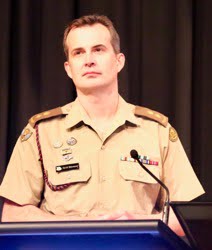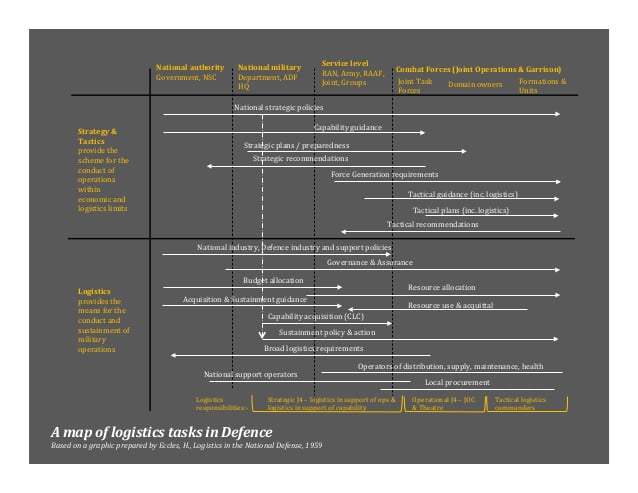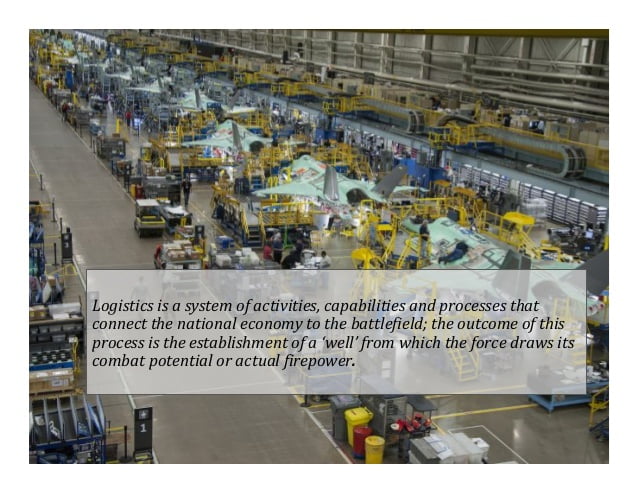By Lt. Col. Beaumont
So, how did we get here?
What does it mean to be a logistician now, and what will a future logistician look like?
These are big questions.
Impossibly big questions.
To have a sense of a ‘profession’ you must first have an idea of what I mean by the term ‘we’. Everyone in the room is probably quite confident that they have a definition of what a logistician is; whether you agree with one another is another question.
Are we talking about military staff only, does the definition include acquisition specialists, what about health professionals, and are we interested in Service logisticians operating at the tactical level?
Perhaps we could start by questioning what logistics is. We often choose to define a logistician in terms of a discrete capability. Logistics, much like strategy and tactics, is a process or a way of thinking. It is a comprehensive behaviour that combines science and art to achieve an outcome – the creation and sustainment of combat forces.
Behind logistics is theory and practice, a confluence of activities that takes the raw material – often literally – and creates combat capability and actual firepower.
About the logistician – the logistician is the one that controls this activity, comprising many technical specialities at different levels of Defence, or facilitates the activities of others outside the enterprise. This might include industry partners, research institutions and other organisations. The logistics discipline is defined by systemic thinking, technical competencies, complexity, a balance between logistics organisation and command requirements, collective effort in a shared endeavour; but as we all know, in an environment usually defined by organisational disruption, resource limitations, lack of investment, tremendous oversight and sometimes even contempt, and without a doubt inter-agency conflict.
Now that I say it, it does sound like a difficult business to be in!
Why we are, what we are
It is a difficult business to be in. It is a business that has, in the context of Australian Defence at least, endured tremendous change in recent years. How did we get here, and where did the contemporary logistician come from?
Fortunately for you all, I won’t be giving a long and detailed history of logistics in warfare. Allow me to summarise two or three hundred years of major developments in creating and sustaining deployed forces by telling you that logistics has become increasingly important to the fulfilment of strategy. The industrialisation of war, invention of steam and later combustion engines, the electronic age, the post-WW2 invention of modern business science – all have contributed to increasing the importance of the logistician.
Of course, with increased importance comes expectations and alongside these important technological, technical and theoretical changes have been investigations as to the role of logisticians in war, and what professional skills are required.

Let’s put the topic in our own context and in terms of our own experiences.
The first thing I will say is that we all come from different parts of the Defence organisation, but I feel quite confident in saying that the modern Defence logistician was born nearly thirty years ago.
This is not just because the senior-most members of the audience have been in the Services for about that long! It is because the world was changing, strategy was changing, and logistics was consequently changing. The spectre of great power conflict was receding, and force posture adjusting. The US commenced demobilisation, and forward positions underwritten by war-stocks and strategic reserves, supported by a supply-centric methodology and process, became untenable.
Defence budgets began to decline, and strategy redeveloped to suit a ‘peace dividend’.
Our militaries were faced by considerable pressure as modernisation and ‘block obsolescence’ required a substantial capital expenditure, and personnel expenses were beyond the capacity of defence forces to sustain.
Government pressure accelerated the rationalisation of strategic logistics systems, Services chose to bear the brunt of pressure in their logistics organisations and mass commercialisation began to occur through programs such as the Commercial Support Program. The 1991 Commercial Support program and 1997 Defence Efficiency Review (DER) had profound consequences for the ADF and Department.
As General David Hurley describes in Nicholas Jans’s The Chiefs (p54), without a compelling intellectual argument to counter, outsourcing and commercialisation irrevocably changed the logistics and organisational landscape. Logisticians were compelled to be more efficient, and the language of the time echoed ‘best business practice’. Increased industry involvement and other factors created new professional requirements.
Operational experiences, set in this strategic and organisational climate, accentuated the evolutionary path. American performance in the 1991 Gulf War, an operation which truly showed how importance logistics was to the ability of a military to prosecute a war quickly, was a catalyst for even more reform. The ‘iron mountains’ that enabled a tremendous success in this war were perceived to be the vestiges of outdated supply-based concepts, and with the ‘revolution in military affairs’ came the ‘revolution in military logistics’ (RML). RML, originating in the US military, desired a revolution in process, organisation and skills relevant to logisticians.
Professional pathways were efficiently amalgamated, distribution-based logistics instituted, centralisation emphasised, and the military and public service logistician increasingly compared to their private sector equivalents. These changes became a phenomenon among most Western militaries, who substantially adjusted their logistics force structures. This period truly defined the approach logisticians would take for the next twenty-five years.
This period resulted in a significant transfer of skills as jobs formerly performed by military logisticians were increasingly performed by public servants and industry partners. The establishment of the first truly joint logistics command in Support Command Australia as a key outcome of the DER was not just to improve the ADF’s operational effectiveness. Commander Support Command Australia, Lieutenant General Des Mueller, was directed to centralise, consolidate and outsource many strategic logistics functions.
The subsequent consolidation of SCA, National Support Division and the Defence Acquisition Organisation into the Defence Materiel Organisation over the 2000-01 period cemented the expectations of whom would perform what.
These were immensely significant changes a decade in the making, conducted in a time of strategic and organisational turbulence we have not seen since. In my own Service, the training of military logisticians – reformed during the 1996 creation of the Army Logistics Training Centre – was largely focussed on military logistics operations.
With this, the expectation of military logisticians to perform certain strategic and operational functions had certainly diminished. I don’t want to overstate the importance of these changes at the individual training level, but they were important indicators of the shifting ‘professional tide’ in terms of the expectations placed upon logisticians.
The operations came quickly, and with little opportunity to bed in changes.
East Timor was an immensely challenging experience for the ADF and its coalition partners, but before adequate responses to capability and professional gaps could be addressed, we were part of a new coalition in the Middle-east. Much of the impetus to reform Defence logistics in an operational or professional context withered away.
Keeping the pace with these operations was organisationally difficult, especially for those in the DMO which as was assailed by successive reviews. In the ADF, infant joint organisations stagnated as resources were directed to sustaining combat forces. Reform was attempted in the Air Force, and Army focussed upon relatively significant changes in its organisational structure and capability.
There was little time to invest in professional development, little time to do much else than support the sustainment of operations, and few resources and people available to give substance to the intent of successive logistics commanders.
Why we are, where we are
The Defence logistician is built by training systems primarily focussed on tactical command or technical ability, an amorphous approach to professional military education, an over-reliance on experience, in an environment of fractured professional leadership, and often because of good luck.
Thirty years of change, including two decades of sustained operations, has impeded the development of a coherent approach to professionalisation. It has made it exceptionally difficult to approach skilling and technical expertise as a collective, and a variety of professional workarounds have consequently emerged. The preparation of logisticians is done so within federation of like-minded individuals.
Although the Defence organisation may be increasingly centralised and joint in nature, its collective approach to professional development and training is immature. The shifting organisation has traditionally separated natural sources of leadership and made ownership of the ‘professional problem’ unclear. Without advocacy and engagement, gains achieved in logistics performance and capability development have been limited.
Reform within the Services, sometimes because of responding to operational deficiencies and others in recovery from the lean 1990s, also meant some efforts undertaken in the enterprise had diverged from another.
These points of divergence have been exacerbated by operational experiences.
The last decade and a half has been one in which the enterprise has done the best it can.
However, while we have focussed on supporting individual achievement through an overemphasis on posting experiences (operational service, secondments and other activities) – the approach to training and educating the collective has been lacking. This approach has affected the basic level of competency of Defence logistics staff.
We do not have a systemic approach to preparing Defence logisticians; a good training system is present, especially for our junior military members, but there is no agreed upon model to take the most junior military and public servant logistician to senior appointments.
This is a symptom of fractured professional leadership and, for some time, no clear ‘owner’ of the task to prepare logisticians at the enterprise level.
A complex task
Our history reveals much about the reasons why the contemporary logistician ‘looks’ and ‘acts’ the way they do, what skills they possess, and how they relate to one another.
Of course, it is not the only reason we – as logisticians – are where we are. Logistics is an enormous problem. It is simply impossible to adequately prepare the logistician for the full range of tasks, employment opportunities and requirements across the full breadth of the Defence enterprise. A logistician, even at a junior level, faces a challenge that other career paths in military organisations will not be exposed to until senior ranks. It is massively complex, and to be successful as a logistician requires you to be able to navigate a substantial portion of the institution.
It is an activity that begins with the national economy, with policy making and resourcing, and ends with the delivery of materiel and personnel to the combat force fighting at the forward edge of the battlefield. It comprises and enormous number of functions across the breadth of Defence – Department and ADF – performed by large numbers of technical specialists, generalist officers and public servants, industry partners and contractors and officials.
The graphic below shows the generic logistics functions that are performed within the Defence enterprise.

These functions are divided into two main areas.
The bottom half of the slide shows that logistics is concerned with the development of the means for, and the sustainment of, military operations.
It comprises a substantial proportion of the tasks a Defence logistician is expected to perform, as well as a number performed by others.
The second area relates to the formulation of strategy, including policy, and military tactics.
You might think logisticians are only responsible for the provision of staff advice, but the real important work of the strategic logistician is in this space where their work sets in motion the Defence approach to industry policy and engagement, national support, acquisition inputs into strategy and other planning responsibilities.
Logisticians are not the sole owners of these problems, but they are quite clearly critical in traversing the spectrum.
Success in this environment requires us all to understand which areas require emphasis given circumstances, and where the authority for decision making and activity lies.
This, unfortunately, is hardly an easy task!
This transcript is the first half of a speech given at the 2018 Australian and New Zealand Defence Logistics Conference.
The session was titled ‘The Future Logistician’.
The second part of this transcript will be posted soon.
David Beaumont is a serving Australian Army officer and the thoughts here are is own.
This article was originally published on the website Logistics in War on November 10, 2019.


